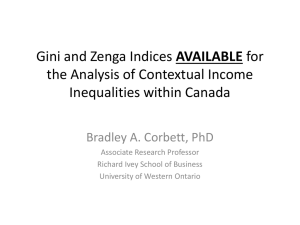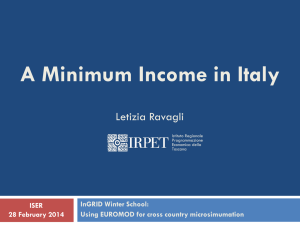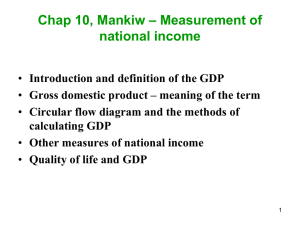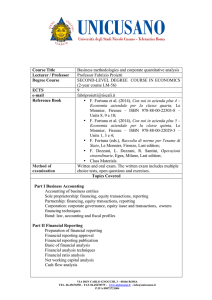Inequality: What has been happening, why does it matter, and
advertisement
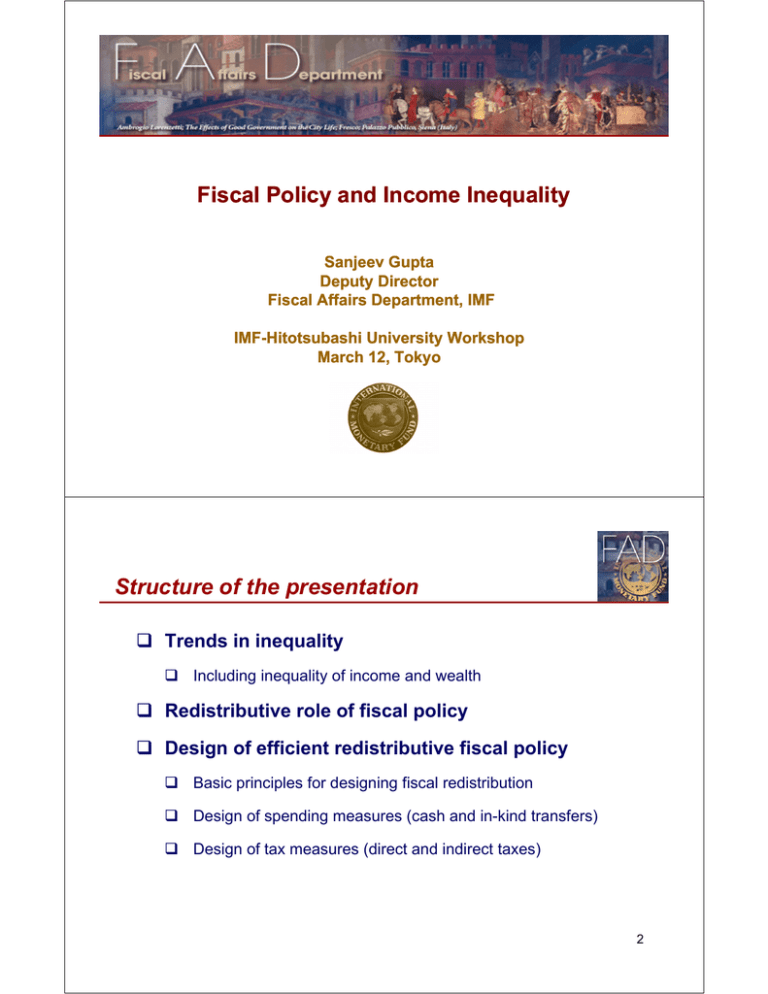
Fiscal Policy and Income Inequality
Sanjeev Gupta
Deputy Director
Fiscal Affairs Department, IMF
IMF--Hitotsubashi University Workshop
IMF
March 12, Tokyo
Structure of the presentation
Trends in inequality
Including inequality of income and wealth
Redistributive role of fiscal policy
Design of efficient redistributive fiscal policy
Basic principles for designing fiscal redistribution
Design of spending measures (cash and in-kind transfers)
Design of tax measures (direct and indirect taxes)
2
I Trends
I.
T
d in
i Inequality
I
lit
3
Inequality has been increasing in most
economies
0.55
05
0.5
Gini coefficie
ent
0.45
04
0.4
0.35
03
0.3
0.25
02
0.2
1980
1985
1990
Advanced (21)
Emerging Europe (21)
Middle East and North Africa (12)
1995
2000
2005
2010
Asia and Pacific (14)
Latin America and Caribbean (19)
Sub-Saharan Africa (22)
4
Global Inequality and Income Growth
5
Inequality Between Countries Down,
Inequality Within Countries Up
Income Inequality in the 1980s and 2000s
World Gini Coefficient, 1970 - 2006
0.69
75
Inequaality (Gini Index) 2000s
0.68
0.67
0.66
0.65
0.64
0.63
0.62
0.61
0.6
ZAF
65
55
45
35
HTI
BOL
HNDCOL
CPV GTM
ZMB
PER
CHLBWA
LSO
PRY HKG PAN
NPL
ECU
BRA
KEN
CRI
CIV
DOM
RUS
LKA
RWA
MEX SLE
SLV
THA
URY
NGA MDG
CMR
ARG
GAB
TKM
MAR
GHASGP IRNPHL
MKD
GEO CHN
JOR MLI UGAVEN
MUS
MWI
ARM
MYS
TTO
TUR
UZB
KAZ
ISR IDN
TUN
LVAGBR USA
KGZ
LTU
MDA
MRT
BGR
DZATZA
IND
AUS PRT PAK
TJK
ROM
ESP
ITA
NZL
GRC BGD
EGY
CAN
KOR
EST
JPN
AZE
CHEIRL BHS
POL
UKR
CYPDEU
FRA ETH
LUX
HRV AUT
BLR NLD
DNK
HUN
CZE
FIN
BEL
SVN
SVK
NOR
SWE
JAM
Advanced Economies
Emerging Markets
25
Low Income Countries
197
70
197
72
197
74
197
76
197
78
198
80
198
82
198
84
198
86
198
88
199
90
199
92
199
94
199
96
199
98
200
00
200
02
200
04
200
06
0.59
2World inequality is
defined by the Gini Index, assuming the
world is one country. Source: Sala-i-Martin (2006).
6
15
15
25
Source: Solt (2009)
35
45
55
65
75
Inequality (Gini Index) 1980s
6
In Asia, although poverty has decreased
substantially, inequality has increased
Gini Coefficient
Po ert ($2/da
Poverty
($2/day)) and Gro
Growth
th 1990-2010
1990 2010
0.5
10
MYS
0.45
MYS
-10
PHL
-20
0.4
NPL THA
IDN
-40
THA
LKA
KHM
LKA
KHM
30
-30
PHL
CHN
BGD IND
LAO
20
010
Absolute Change
A
e in Poverty Rate
e
2010 Average = 0.37
1990 Average = 0.35
TWN
0
#N/A
LAO MNG
VNM
0 35
0.35
IDN
0.3
VNM
IND
NPL
BGD
TWN
-50
0.25
CHN
-60
0.2
-70
0
0.2
2
4
6
8
10
Average Annual Growth Rate (GDP per Capita)
0.25
0.3
0.35
1990
0.4
0.45
0.5
Countries included: BGD=Bangladesh; BTN=Bhutan; KHM=Cambodia; CHN=China; FJI=Fiji; IND=India; IDN=Indonesia; KIR=Kiribati; KOR=Korea, Republic of;
7
LAO=Laos; MYS=Malaysia; MDV=Maldives; MHL=Marshall Islands; MNG=Mongolia; MMR=Myanmar; NPL=Nepal; PNG=Papua New Guinea;
PHL=Philippines; WSM=Samoa; SLB=Solomen Islands; LKA=Sri Lanka; THA=Thailand; TON=Tonga; VUT=Vanuatu; VNM=Vietnam; PAK=Pakistan.
More recently, the focus has been on the
rising income share of top income earners
Perc
cent
Gross Income Share of Top One-Percent in Selected Advanced
and Developing Economies, 1925–2012
25
25
20
20
15
15
10
10
5
5
0
0
United Kingdom
South Africa
China
Australia
India
Canada
United States
France
Germany
Japan
Netherlands
Sweden
Mauritius
8
Public support for redistribution has
been rising
g
Public Support for Redistribution
0.9
AUT
SVN
ROM
DEU
Late 2000s
HUN
EST
CHN
CAN
RUS
USA
NGA
MLT
0.3
GEO
LVA
SRB
CHE
TUR
ALB
ESP
AZE
IND
CHL
SWE
FIN
SVK
MDA IRL
ARG
GBR
LTU
BLR
POL
0.5
HRV
BIH
0.7
NORISLMNE
BRA
BEL
AUS
ITA
ARM
NLD
MEX
PRT
ZAF
KOR
JPN
DNKTWN
BGR UKR
PER
FRA
URY
MKD
0.1
0.1
0.3
0.5
Late 1990s
0.7
0.9
Source: Integrated Values Survey 1981-2008
9
9
Wealth is even more unequally distributed
100
Wealth Gini = 70.7
Disposable income Gini = 37.7
90
80
70
60
50
40
30
20
10
PAK
BGD
NPL
VNM
MNG
MDV
LAO
KHM
VUT
TON
LKA
SLB
CHN
FJI
PNG
KOR
THA
PHL
IND
MYS
IDN
0
Source: Di
S
Disposable
bl iincome Gini
Gi i is
i ttaken
k from
f
OECD;
OECD Luxembourg
L
b
IIncome St
Study
d D
Database;
t b
S
Socio-Economic
i E
i D
Database
t b
ffor L
Latin
ti
America and the Caribbean (SEDLAC); World Bank; Eurostat. Wealth Gini data comes from Credit Suisse Global Wealth Databook
(2012).
Countries included: BGD=Bangladesh; BTN=Bhutan; KHM=Cambodia; CHN=China; FJI=Fiji; IND=India; IDN=Indonesia; KIR=Kiribati; KOR=Korea, Republic of;
10
LAO=Laos; MYS=Malaysia; MDV=Maldives; MHL=Marshall Islands; MNG=Mongolia; MMR=Myanmar; NPL=Nepal; PNG=Papua New Guinea;
PHL=Philippines; WSM=Samoa; SLB=Soloman Islands; LKA=Sri Lanka; THA=Thailand; TON=Tonga; VUT=Vanuatu; VNM=Vietnam; PAK=Pakistan.
Intergenerational income mobility is higher
in countries with low income inequality
q
y
Generation
nal earnings elasticity (le
ess mobility →)
0.5
GBR
ITA
CHE
FRA
0.4
USA
ESP
JPN
GER
0.3
NZL
SWE
AUS
0.2
FIN
CAN
NOR
DNK
y = 0.0251x - 0.3709
0.1
20
25
30
Gini (around 1985; higher inequality→)
35
11
II. Redistributive Role of Fiscal
Policy
12
Redistributive fiscal policy reduces inequality by one
third in advanced economies,
economies mostly through spending
0.30
From taxes
Average market income Gini: 0.43
From transfers
Average disposable income Gini: 0.29
Absolutte Gini reduction
0.25
0.20
Total redistribution = 0.14
0.15
From transfers = 0.09
0.10
0.05
KOR
ESP
GRC
ITA
EST
USA
CAN
ISR
NLD
IRL
AUS
FRA
DEU
LUX
SWE
FIN
AUT
GBR
NOR
SVN
BEL
DNK
CZE
0.00
Countries included: AUS=Australia; AUT=Austria; BEL=Belgium; CAN=Canada; CZE=Czech Republic; DEU=Germany;
DNK=Denmark; ESP=Spain; EST=Estonia; FIN=Finland; FRA=France; GBR=United Kingdom; GRC=Greece; ISR=Israel;
IRL=Ireland; ITA=Italy; KOR=Korea; LUX=Luxembourg; NLD=Netherlands; SVN=Slovenia; SWE=Sweden; TWN=Taiwan
Province of China; USA=United States.
13
Fiscal redistribution also low reflecting
low revenues and social spending
Composition of revenues, 2010
(Percent GDP)
Composition of social spending, 2010
(Percent GDP)
45
30
40
25
3
35
30
20
25
15
20
10
15
10
5
5
0
Advanced
{31}
Emerging
Europe
{21}
Latin America
{27}
Sub-Saharan Asia and Pacific
Africa
{24}
{36}
MENA
{21}
Indirect taxes
Income taxes and contributions
Corporate Income Tax Revenue
Other tax revenue
Total revenue mean
0
Advanced
{30}
Emerging
Europe
{19}
Social
i l protection
i
South
America
{10}
Central
America and
Caribbean
{13}
Health
lh
MENA
{14}
Asia and
Pacific
{22}
Sub-Saharan
Africa
{29}
Education
d
i
14
Social protection spending also low in Asia
14
12
10
8
6
4
2
0
Social protection, public spending (percent GDP)
APD median
APD population weighted average
Countries included: BGD=Bangladesh; BTN=Bhutan; KHM=Cambodia; CHN=China; FJI=Fiji; IND=India; IDN=Indonesia; KIR=Kiribati; KOR=Korea, Republic of;
LAO=Laos; MYS=Malaysia; MDV=Maldives; MHL=Marshall Islands; MNG=Mongolia; MMR=Myanmar; NPL=Nepal; PNG=Papua New Guinea;
15
PHL=Philippines; WSM=Samoa; SLB=Soloman Islands; LKA=Sri Lanka; THA=Thailand; TON=Tonga; VUT=Vanuatu; VNM=Vietnam; PAK=Pakistan.
…. and low spending reflected in low
coverage of social insurance…..
Percent of Population above Legal Retirement Age in Receipt of a Pension
100
90
87%
86%
80
70
60
50
38%
40
37%
30
22%
21%
Asia and Pacific
(n=19)
Sub-Saharan Africa
(n=27)
20
10
0
Advanced (n=27)
Emerging Europe Middle East and
(n=18)
North Africa (n=17)
Latin America
(n=21)
16
…..especially among lower-income
lower income groups
Social Protection Coverage and Benefit Share of Poorest 40%
60
Benefit In
ncidence (Percen
nt)
Median = 42.5
50
40
30
20 Median = 14.6
10
0
0
10
Asia and Pacific
20
30
40
50
60
Coverage (Percent)
Latin America and Caribbean
70
80
Middle East and North Africa
90
100
Sub-Saharan Africa
Social protection includes pensions and social assistance transfers
17
Health spending low and outcomes
poor…….
10
9
Health, public spending (percent GDP)
APD median
60
APD population weighted average
8
Mortality rate, infant (per 1,000 live births)
APD median
50
APD population weighted average
7
40
6
5
30
4
3
20
2
10
SS Africa
MENA
Cen
ntral America
So
outh America
Emeerging Europe
Advanced
0
PNG
KIR
IND
KHM
NPL
BGD
SLB
IDN
PHL
MNG
FJI
VNM
VUT
CHN
THA
TON
MDV
LKA
MYS
BRN
Advanced
Eme
erging Europe
Latin America
L
SS Africa
MENA
0
KIR
SLB
NPL
VUT
TON
MDV
FJI
MNG
THA
CHN
VNM
PNG
MYS
BRN
KHM
LKA
IDN
PHL
IND
BGD
1
Countries included: BGD=Bangladesh; BTN=Bhutan; KHM=Cambodia; CHN=China; FJI=Fiji; IND=India; IDN=Indonesia; KIR=Kiribati; KOR=Korea, Republic of;
LAO=Laos; MYS=Malaysia; MDV=Maldives; MHL=Marshall Islands; MNG=Mongolia; MMR=Myanmar; NPL=Nepal; PNG=Papua New Guinea;
18
PHL=Philippines; WSM=Samoa; SLB=Soloman Islands; LKA=Sri Lanka; THA=Thailand; TON=Tonga; VUT=Vanuatu; VNM=Vietnam; PAK=Pakistan.
………with gaps in health coverage among
lower-income
lower
income groups
Shares of Health Spending Benefiting the Poorest 40%
80
70
60
50
40
30
20
10
IND 1996
ECU 1998
GHA 1998
ROM 1997
THA 2008
GTM 2010
BGR 1995
MOZ 1997
SLV 2011
TUR 2003
IDN 2012
ZMB 2009
ETH 2011
BGD 2000
MEX 2010
ARM 2011
MNG 1995
ZAF 2010
HND 2004
BLR 2002
PER 2009
BOL 2009
BRA 2009
EGY 2005
BOL 2007
URY 2009
COL 2010
CHL 2009
ARG 2009
0
Source: Lustig (2015); Davoodi, Tiongson, and Asawanuchit (2010); Lustig et. Al (2011); World Bank..
Countries included: ALB=Albania; ARG=Argentina; ARM=Armenia; AZE=Azerbaijan; BEN=Benin; BGD=Bangladesh; BIH=Bosnia and Herzegovina;
BOL=Bolivia; BRA=Brazil; CHL=Chile; CIV=Cote d’Ivoire; COL=Colombia; CRI=Costa Rica; EGY=Egypt; ETH=Ethiopia; GTM=Guatemala; IDN=Indonesia;
IND=India; KEN=Kenya; KHM=Cambodia; KSV=Kosovo; LBR=Liberia; LSO=Lesotho; MEX=Mexico; MOZ=Mozambique; NAM=Namibia; NPL=Nepal; 19
PER=Peru; SLV=El Salvador; THA=Thailand; TUR=Turkey; UGA=Uganda; URY=Uruguay; UZB=Uzbekistan; ZAF=South Africa; ZMB=Zambia.
Low education spending also leads to low
education outcomes…..
100
12
Education, public spending (percent GDP)
Secondary net enrollment rate
APD median
90
APD population weighted average
APD median
10
APD population weighted average
80
70
8
60
50
6
40
30
4
20
2
SS Africa
Central America
MENA
South America
Eme
erging Europe
Advanced
KHM
SLB
BGD
VUT
NPL
PHL
MYS
IDN
THA
MNG
FJI
LKA
Advanced
LLatin America
MENA
Emeerging Europe
SS Africa
0
KIR
MYS
MDV
THA
PNG
FJI
BRN
SLB
VUT
IND
TON
MNG
VNM
PHL
IDN
NPL
CHN
LKA
BGD
KHM
0
BRN
10
Countries included: BGD=Bangladesh; BTN=Bhutan; KHM=Cambodia; CHN=China; FJI=Fiji; IND=India; IDN=Indonesia; KIR=Kiribati; KOR=Korea, Republic of;
LAO=Laos; MYS=Malaysia; MDV=Maldives; MHL=Marshall Islands; MNG=Mongolia; MMR=Myanmar; NPL=Nepal; PNG=Papua New Guinea;
20
PHL=Philippines; WSM=Samoa; SLB=Soloman Islands; LKA=Sri Lanka; THA=Thailand; TON=Tonga; VUT=Vanuatu; VNM=Vietnam; PAK=Pakistan.
……and gaps in coverage among lowerincome groups
Shares of Education Spending and Market Income Benefitting the Poorest 40%
80
70
60
50
40
30
20
10
BGD 2000
ZMB 2009
ETH 2011
UGA 2006
EGY 2005
MOZ 2003
CIV 2008
BEN 2003
UZB 2000
NPL 2004
BOL 2007
THA 2008
LBR 2008
KSV 2000
AZE 2001
IDN 2012
TUR 2001
KHM 2002
CRI 2001
KEN 2006
BOL 2009
BIH 2001
GTM 2010
ALB 2002
ZAF 2010
COL 2010
MEX 2010
CHL 2009
ARM 2011
SLV 2011
URY 2009
PER 2009
ARG 2009
LSO 2002
BRA 2009
NAM 2003
0
Source: Lustig (2015); Davoodi, Tiongson, and Asawanuchit (2010); Lustig et. Al (2011); World Bank..
Countries included: ALB=Albania; ARG=Argentina; ARM=Armenia; AZE=Azerbaijan; BEN=Benin; BGD=Bangladesh; BIH=Bosnia and Herzegovina;
BOL=Bolivia; BRA=Brazil; CHL=Chile; CIV=Cote d’Ivoire; COL=Colombia; CRI=Costa Rica; EGY=Egypt; ETH=Ethiopia; GTM=Guatemala; IDN=Indonesia;
IND=India; KEN=Kenya; KHM=Cambodia; KSV=Kosovo; LBR=Liberia; LSO=Lesotho; MEX=Mexico; MOZ=Mozambique; NAM=Namibia; NPL=Nepal; 21
PER=Peru; SLV=El Salvador; THA=Thailand; TUR=Turkey; UGA=Uganda; URY=Uruguay; UZB=Uzbekistan; ZAF=South Africa; ZMB=Zambia.
…and there is no “Robin Hood” paradox
p
In Kind-Social Spending and Market Income Inequality, 2010
Educa on/GDP vs Mkt Income Gini
9%
Health/GDP vs Mkt Income Gini
BOL
6%
8%
6%
5%
H e a lth /G D P
E duca on/GD P
7%
BRA
ETH
MEX
4%
IND
3%
ARM
SLV
URY
PER
CHL
GTM
BRA
5%
ZAF
COL
SLV
CHL
3%
PER MEX
ARM
ETH
IND
0%
1%
0.4
0.4
0.5
0.5
0.6
0.6
Mkt Income Gini
COL
GTM
1%
2%
0.3
ZAF
BOL
4%
2%
2%
URY
0.7
0.7
0.8
0.8
0.3
0.4
0.4
0.5
0.5 0.6 0.6
Mkt Income Gini
0.7
0.7
0.8
Source: Lustig (2015).
Countries included: ARM=Armenia; BOL=Bolivia; BRA=Brazil; CHL=Chile; COL=Colombia; ETH=Ethiopia; GTM=Guatemala; IND=India; MEX=Mexico;
22
PER=Peru; SLV=El Salvador; URY=Uruguay; ZAF=South Africa.
0.8
Energy subsidies are high and sometimes
exceed social spending
p
g
(In percent of GDP, 2011)
12
Tax subsidies
Pretax subsidies
10
Education spending
Health spending
8
6
4
2
Myanmar
Sri Lanka
Pakistan
India
Indonesia
Fiji
Bhutan
Malaysia
Korea, Republic of
K
Maldives
Thailand
0
23
Most of the benefits from energy subsidies
accrue to upper
pp income households
Distribution of Petroleum Product Subsidies in Asian Countries by Income Groups
(in percent of total product subsidies)
Gasoline
Kerosene
Bottom
quintile
3 6
19
61
19
21
10
20
20
Top
quintile
21
Diesel
LPG
4
7
8
12
13
42
16
54
21
23
24
III. Designing
g
g Efficient
Redistributive Fiscal Policy
25
Designing efficient redistributive fiscal policy
Redistributive fiscal policy should be consistent with
macroeconomic objectives
The impact of tax and spending policies should be
evaluated jointly
Tax and expenditure policies need to be carefully
designed
g
to balance distributional and efficiency
y
objectives
Design should take into account administrative capacity
26
Reform options to achieve more efficient
redistribution of social spending
Social transfers
Expand
p
conditional cash transfer (CC
(CCT)) p
programs
g
as administrative
capacity improves (e.g., programs exist in Bangladesh, Cambodia, India,
Indonesia, Nepal and Philippines)
Expand noncontributory social pensions – as means-tested (e.g.
Bangladesh, Korea, Malaysia, Nepal, Viet Nam), pensions-tested (e.g.
Fiji,
j Thailand)) or a universal cash transfer ((e.g.
g Brunei, PNG, Timor))
Remove general price subsidies and better target social transfers (e.g.,
Indonesia)) byy addressing:
g
• Fragmentation and duplication—reduce number of programs (Vietnam)
• Low coverage and benefits—expand coverage with savings from targeting
• Reliance on costl
costly in
in-kind
kind benefits
benefits—use
se cash benefit (China,
(China India)
Expand public works programs (e.g., Bangladesh, India)
27
Reform options to achieve more efficient
redistribution of social spending
Health
Expand coverage of publicly financed basic health package and health
insurance (China, Vietnam)
Reduce or eliminate user charges for low-income households (e.g.,
Indonesia)
Address supply-side barriers in less developed areas (e.g. Bangladesh,
Laos, Vietnam)
Improve efficiency of health spending
28
Reform options to achieve more efficient
redistribution of social spending
Education
Improve access of low-income families to education by:
• increasing investment in lower levels of education (Philippines)
g on access and p
progression
g
to p
primary
y and lower-secondary
y
• focusing
education (e.g. Bhutan, Cambodia, Iran, Lao, Mongolia)
expanding coverage for girls and students in rural areas (e.g.
Bangladesh, India)
•
29
Reform options to achieve more efficient
redistribution of taxation
Personal income taxation
Implement progressive Personal Income Tax (PIT) rate structures (e
(e.g.
g Korea,
Korea
Thailand, Viet Nam)
Expand
pa d co
coverage
e age o
of the
e PIT
Reconsider income tax exemptions, based on a critical tax-expenditure review
(e.g., India, Indonesia, China)
Impose a reasonable PIT exemption threshold
Capital income taxation
Develop more effective taxation of multinationals (e.g. China, India, Japan)
Exchange information internationally
30
Reform options to achieve more efficient
redistribution of taxation
Property taxation
Utilize better the opportunities for recurrent property taxes (e.g. Hong Kong,
Singapore, Viet Nam)
• Improve administrative infrastructure
Cons mption taxation
Consumption
ta ation
Minimize VAT exemptions and special VAT rates
Set a sufficiently high VAT registration threshold (e.g. Indonesia, Singapore,
Viet Nam)
U specific
Use
ifi excises
i
mainly
i l ffor purposes other
th than
th redistribution
di t ib ti
31
Thank you!
32
